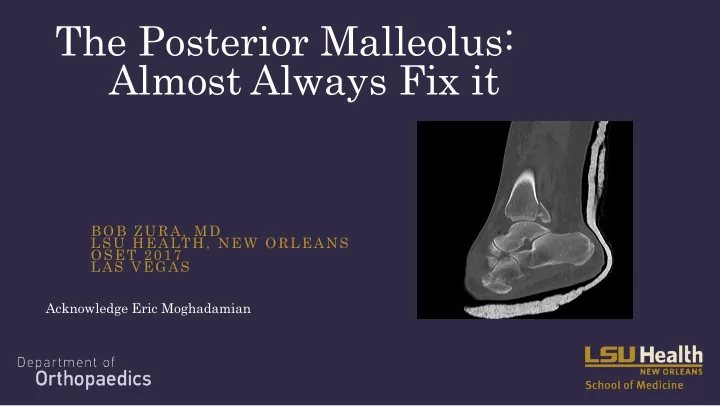

The Posterior Malleolus: Almost Always Fix it BOB ZURA, MD LSU HEALTH, NEW ORLEANS OSET 2017 LAS VEGAS Acknowledge Eric Moghadamian
Disclosures • Consultant: – Smith-Nephew – Bioventus – Cardinal Health
Assumption • Anatomic reduction of the ankle joint and syndesmosis correlates to better tibio-talar contact pressures and better clinical outcomes.
The Problem • We are ter errib ible le at diagnosing and reducing syndesmotic injuries • It occurs frequently in association with ankle fracture and we miss them – Mostly PER injuries Weening and Bhandari, 2005 Parikenen et al., 2011 JBJS – But also in SER with no widening on static films: Syndesmotic Instability in Weber B Ankle Fractures: A Clinical Evaluation Stark, Erik MD; Tornetta, Paul III MD; Creevy, William R MD Journal of Orthopaedic Trauma 2007
The Problem • AND even when recognized and treated in an acceptable manner, we often get it wrong. – Incidence of malreduction based on CT scan “standard”: >50% – Gardner et al. FAI 27: 788-92, 2006. • We know this and still don’t get CT’s!
The Functional Consequence of Syndesmotic Joint Malreduction at a Minimum 2-Year Follow-Up Sagi, H. Claude MD; Shah, Anjan R. MD; Sanders, Roy W. MD Journal of Orthopaedic Trauma Issue: Volume 26(7), July 2012, p 439–443 • From January 1, 2004, to December 31, 2006, 107 of 681 operatively treated ankle fractures (15.7%) had associated syndesmotic injuries requiring reduction and fixation. • All patients available at a minimum of 2 years postindex procedure underwent clinical and radiographic examination, computed tomographic (CT) scanning of both ankles (injured and uninjured) • functional outcome scoring using the Short Form Musculoskeletal Assessment and Olerud/Molander questionnaires.
The Functional Consequence of Syndesmotic Joint Malreduction at a Minimum 2-Year Follow-Up Sagi, H. Claude MD; Shah, Anjan R. MD; Sanders, Roy W. MD Journal of Orthopaedic Trauma Issue: Volume 26(7), July 2012, p 439–443 • Sixty-eight of 107 (63.5%) syndesmotic injuries in 68 patients were available for follow-up. • Twenty-seven (39%) were malreduced (rotational or translational asymmetry) when compared with the contralateral uninjured syndesmotic joint.
The Functional Consequence of Syndesmotic Joint Malreduction at a Minimum 2-Year Follow-Up Sagi, H. Claude MD; Shah, Anjan R. MD; Sanders, Roy W. MD Journal of Orthopaedic Trauma Issue: Volume 26(7), July 2012, p 439–443 • Fifteen percent of the open syndesmotic reductions were malreduced on postoperative CT scans, whereas 44% (A/B) of the closed syndesmotic reductions were malreduced on postoperative CT scan (P = 0.11). • Patients with a malreduced syndesmosis recorded significantly worse functional outcome scores (P < 0.05) on both the Short Form Musculoskeletal http://m8.i.pbase.com/o4/53/688553/1/92037578.lA9AXs4m.neworleans_pano_std.jpg
The Functional Consequence of Syndesmotic Joint Malreduction at a Minimum 2-Year Follow-Up Sagi, H. Claude MD; Shah, Anjan R. MD; Sanders, Roy W. MD Journal of Orthopaedic Trauma Issue: Volume 26(7), July 2012, p 439–443 • At a minimum of 2 years follow-up, patients with malreduced syndesmotic injuries demonstrated significantly worse functional outcome using the Short Form Musculoskeletal Assessment and Olerud/Molander questionnaires. • Open reduction of the syndesmosis resulted in a substantially lower rate of malreduction when evaluated by postoperative CT scan.
The Functional Consequence of Syndesmotic Joint Malreduction at a Minimum 2-Year Follow-Up Sagi, H. Claude MD; Shah, Anjan R. MD; Sanders, Roy W. MD Journal of Orthopaedic Trauma Issue: Volume 26(7), July 2012, p 439–443 • Based on these findings, we recommend that surgeons not only perform a direct, open visualization of the syndesmosis during the reduction maneuver, but obtain a postoperative CT scan with comparison to the contralateral extremity as well. • If the syndesmosis is found to be malreduced, consideration must be given to revising the osteosynthesis.
So…… • If there is a posterior malleoulus – why don’t we fix it and get it anatomic?
Is there an anatomic solution? Clin Orthop Relat Res. 2006 Jun;447:165-71.
Posterior Malleolus • The PITFL complex is thought to contribute the most to stability of the ankle syndesmosis • 15 consecutive patients with closed PER Stage 4 ankle fractures involving the posterior malleolus underwent MRI • 0/15 patients with posterior malleolar fractures had complete PITFL ruptures
Posterior Malleolus • Created a simulated PER Stage 4 with posterior malleolus fx • The fibula was left intact to simulate rigid fixation of a Weber C fibula fracture.
Posterior Malleolus • 5 fixation of posterior malleolus – 70% of intact stiffness • 5 syndesmotic fixation – 40% after using a syndesmotic screw.
Posterior Malleolus: Radiographic and Clinical Evidence • Posterior malleolar fixation vs. open syndesmotic fixation vs. historic controls with closed reduction – Direct visualization for syndesmotic stabilization of ankle fractures. Miller AN, Carroll EA, Parker RJ, Boraiah S, Helfet DL, Lorich DG.Foot Ankle Int. 2009 May;30(5):419-26 – Posterior Malleolar Stabilization of Syndesmotic Injuries is Equivalent to Screw Fixation.Miller AN, Carroll EA, Parker RJ, Helfet DL, Lorich DG.Clin Orthop Relat Res. 2009
Posterior Malleolus: Radiographic and Clinical Evidence • Malreductions were significantly reduced in the direct visualization group • Posterior malleolar reconstruction was the most accurate for syndesmotic reduction • The tibiofibular clear space was better maintained in PM group compared to the S group • Patients with PM/PITFL fixation had functional outcomes at least equivalent to those patients having syndesmotic screw fixation alone
As a result…… • Lower threshold to image and address posterior malleolus
Approaches to Posterior Malleolus
Posterior Malleolus
Percutaneous Rx
Approach (prone) Peroneals FHL
post op
Thank You!
Recommend
More recommend